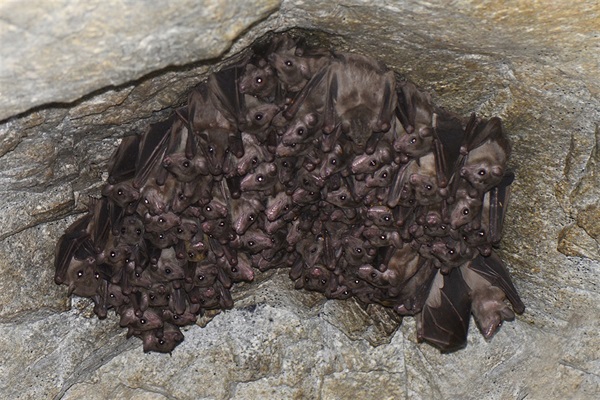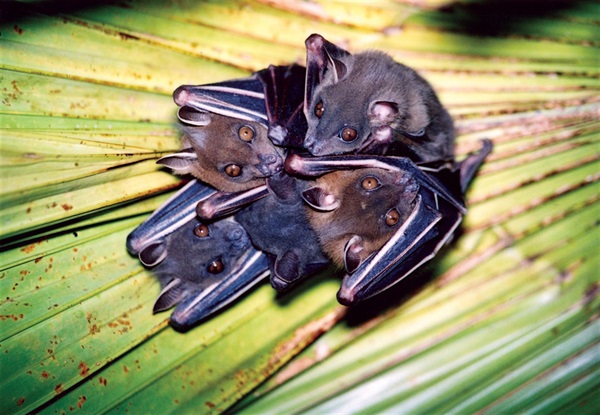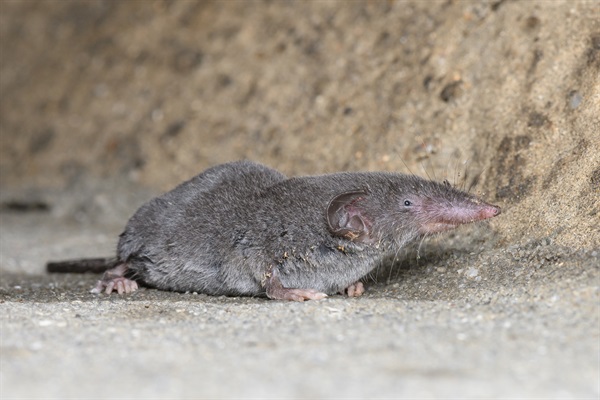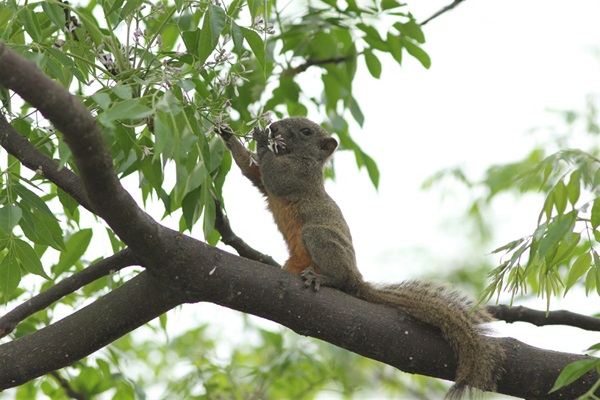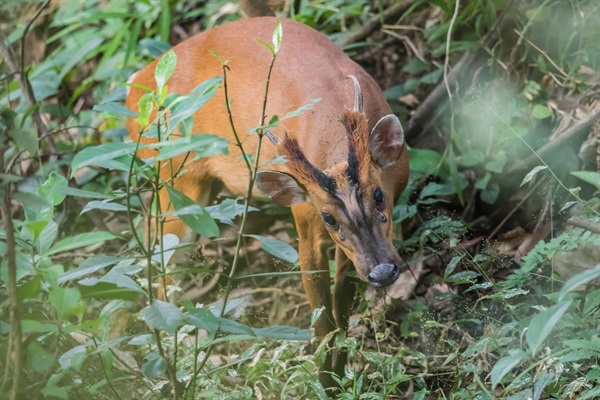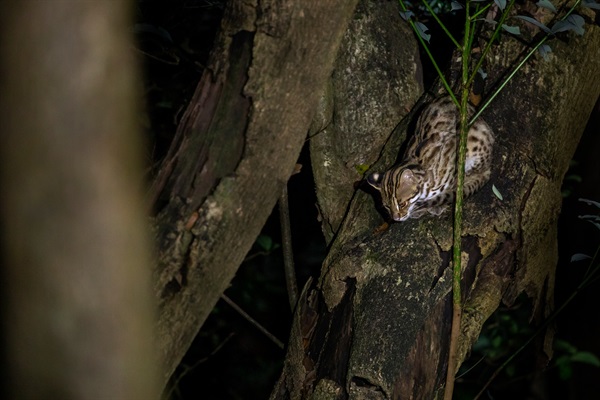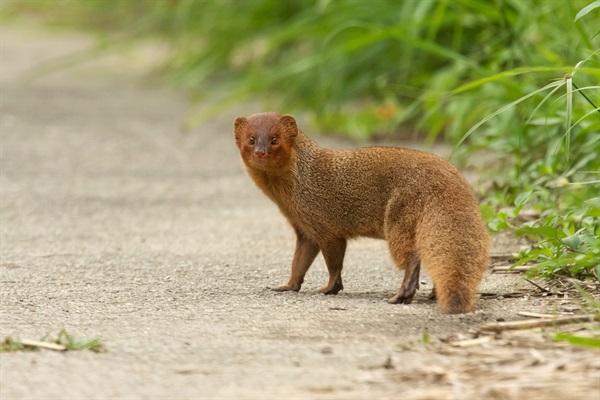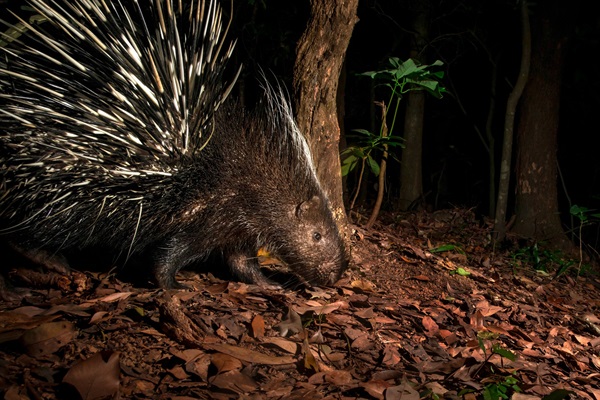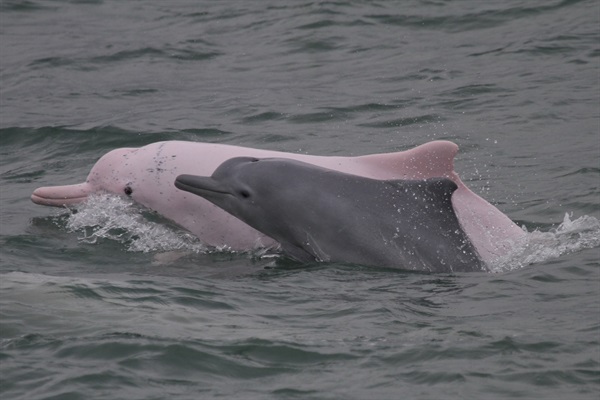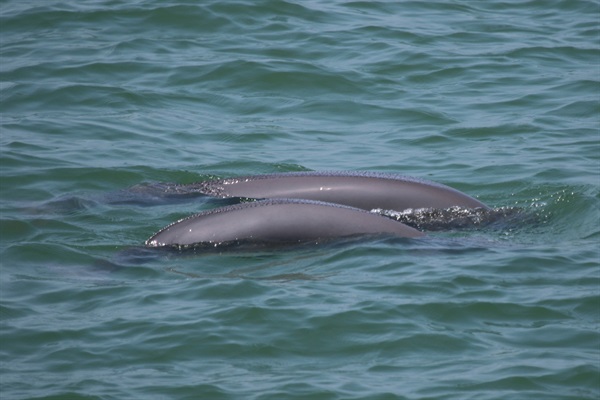Mammals have a great impact on the ecosystem. They utilise many types of food and occupy various habitats. For example, insectivorous bats keep night-flying insects populations in balance; fruit bats disperse pollen of more than 500 plant species in the world. Rodents may also act as seed dispersers as they bury seeds in soil. Large mammals excrete seeds that can potentially be dispersed over long distances.
Terrestrial Mammals
There are 55 existing terrestrial mammalian species in Hong Kong, 25 species are bats and 30 species are non-flying mammals. These 30 non-flying species can be divided into two groups by size: small mammals with head-and-body length less than 25 cm and large mammals with head-and-body length exceeding 25 cm.
Bats constitute almost half of the terrestrial mammal species of Hong Kong. Among 25 bats (order Chiroptera) species, 10 species are widely distributed in water tunnels and abandoned mines; these include Rickett's Big-footed Myotis (Myotis pilosus) and Common Bent-winged Bat (Miniopterus fuliginosus). Some species are common in both rural and urban areas. For example, Short-nosed Fruit Bat (Cynopterus sphinx) roosts under fronds of Chinese Fan-palm and Petticoat Palms in parks, and Japanese Pipistrelle (Pipistrellus abramus) roosts in man-made structures like eaves and crevices of buildings.
Small land mammals in Hong Kong consist of two Insectivora and nine Rodentia. Of our Insectivora, Musk Shrew (Suncus murinus) is more common than Grey Shrew (Crocidura attenuata). Three rat species, Roof Rat (Rattus rattus), House Mouse (Mus musculus) and Brown Rat (Rattus norvegicus), are human commensals. On the other hand, Chestnut Spiny Rat (Niviventer fulvescens) and Indo-Chinese Forest Rat (Rattus andamanensis) are common hillside rats. Lesser Rice-field Rat (Rattus losea) and Ryuku Mouse (Mus caroli) are primarily associated with agricultural areas. Pallas's Squirrel (Callosciurus erythraeus) is commonly seen in urban parks, presumably originated from released or escaped pets.
The remaining 19 species of large mammals consist of two large Rodentia, two primates, 10 Carnivora, four Artiodactyla and one Pholidota (pangolin). Among them, Domestic Cat (Felis catus), Domestic Dog (Canis lupus familiaris), Domestic Ox (Bos taurus), Domestic Water Buffalo (Bubalus bubalis) and Long-tailed Macaque (Macaca fascicularis) are introduced species. The dominant macaque species in Hong Kong is Rhesus Macaque (Macaca mulatta), which is mainly sighted in Kam Shan, Lion Rock, and Shing Mun Country Parks. Small Asian Mongoose (Herpestes javanicus) and Yellow-bellied Weasel (Mustela kathiah) were first recorded in Hong Kong in 2001.
Among the native large mammals, East Asian Porcupine (Hystrix brachyura), Eurasian Wild Pig (Sus scrofa) and Red Muntjac (Muntiacus vaginalis) are the most abundant and widely distributed species in Hong Kong. Small Indian Civet (Viverricula indica) and Leopard Cat (Prionailurus bengalensis) are relatively abundant and widespread, while Small-toothed Ferret Badger (Melogale moschata) and Masked Palm Civet (Paguma larvata) are less abundant but widely distributed. Crab-eating Mongoose (Herpestes urva) was once thought to be extinct in 1960s, until 2001 when it was rediscovered in the northeastern parts of the New Territories. There are only scattered records of Chinese Pangolin (Manis pentadactyla) within Hong Kong territory, making it a scarce local mammal. Eurasian Otter (Lutra lutra) is also a rare species with a highly restricted distribution around Mai Po and Inner Deep Bay areas.
Marine Mammals
Revision of records from various sources confirmed that a total of twenty species of marine mammals (all records are cetaceans) have occurred in waters of Hong Kong. While most of them are occasional visitors, two species are regularly observed in Hong Kong waters and are considered residents, i.e. the Indo-Pacific Humpback Dolphin (Sousa chinensis) and the Finless Porpoise (Neophocaena phocaenoides). Dedicated scientific studies emerged since the 1990s have contributed the knowledge on distribution, abundance, life history and ecology of the two residential cetaceans. Subsequently, unceasing effort has been paid for the long-term monitoring of distribution, abundance and associated temporal trends of the species. Findings from the long-term monitoring provide up-to-date status on the species and are grounds for conservation measures that help their continued survival in Hong Kong waters.
The Indo-Pacific Humpbacked Dolphin (Sousa chinensis), or locally known as Chinese White Dolphin, is found throughout the Western Pacific and Indian Oceans. There are about seven to eight known populations of Chinese white dolphins along the Southern China coast, mainly centred around the mouths of large rivers. One of the populations is located around the Pearl River Estuary, and the dolphin assemblage in Hong Kong waters represent the eastern portion of the population range. Within Hong Kong, dolphins occur regularly in the western waters of Lantau Island. They also use the waters near Deep Bay and South Lantau but to a lesser extent. Length at birth of the dolphin is about 100 cm, and the adults could grow up to 270 cm and weigh 250 kg. The Chinese White dolphin exhibits great developmental variation in colour pattern. Newborns are dark grey and they lighten in the juvenile stage. Young adults apparently continue to lighten and the dark colour gives way to dark spots on a light background. Adult females are pinkish-white in colour, with little or no spots. There may be some sexual dimorphism, with males retaining more spotting in the adult stage. Foraging of the dolphin appears to be mainly on several species of demersal and pelagic fish species, such as lion-head croakers and anchovies, which are generally associated with estuaries. Neither cephalopods nor shrimps appear to be important prey items.
The Finless Porpoise (Neophocaena phocaenoides) occurs in shallow coastal waters (usually < 50 m deep) around the northern rim of the Indian and western Pacific Oceans. Within Hong Kong, finless porpoises are found in all of the southern and eastern waters. The species exhibits seasonal distribution in Hong Kong waters, with higher record in South Lantau and Lamma waters in the dry season; and eastern waters near Po Toi and Ninepins Islands in the wet season. The species show little overlap in distribution with the Chinese White Dolphin in Hong Kong. The new born porpoises are light grey in colour, there is a general darkening of the colour pattern from neonates through adults, and adults become relatively more slender. There is evidence of some sexual dimorphism, with males growing somewhat larger than females. The major food items for finless porpoises are inshore, bottom-dwelling and mid-water preys including squids and cuttlefishes, anchovies and cardinalfishes.
